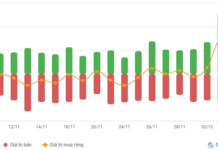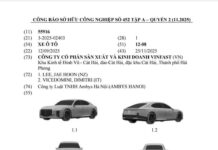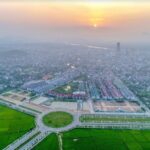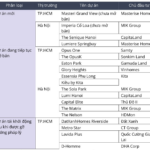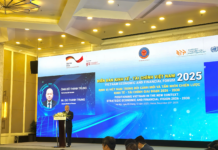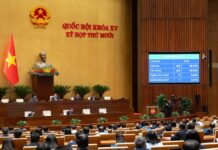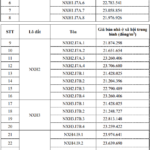
Prime Minister Pham Minh Chinh attends the Vietnam-India Business Forum. (Photo: Duong Giang/VNA)
|
Trade has long been considered a crucial pillar in the Comprehensive Strategic Partnership between Vietnam and India. Over the years, this sector has consistently achieved high growth rates, and 2024 is no exception, with several encouraging milestones.
In an interview with VNA reporters in New Delhi, Vietnam’s Trade Counselor in India, Bui Trung Thuong, highlighted the bright spots in economic and trade cooperation between the two countries in 2024.
For the first time in a decade, a high-ranking Vietnamese delegation, led by Prime Minister Pham Minh Chinh, visited India. The visit yielded significant economic and trade cooperation results, including the successful organization of a business forum that attracted over 300 Indian businesses, among which were prominent groups and companies interested in investing in Vietnam, such as Adani and HCL. The two sides also signed economic and trade cooperation documents to implement the “5 more” direction proposed by the Prime Minister.
It is expected that the trade turnover between Vietnam and India will surpass the $15 billion target set by the leaders of the two countries and is projected to reach $20 billion in the coming years.
To achieve this outcome, the Trade Office in India and the Vietnamese Embassy in India have organized numerous trade promotion programs. At the beginning of the year, from January 10-11, Deputy Prime Minister Tran Luu Quang led a delegation to attend the “Vibrant Gujarat” program, opening up cooperation opportunities for the whole year.
Within the framework of this program, the Trade Office also organized various activities, including an exhibition and a business forum. Additionally, the Trade Office invited a domestic art troupe to participate in a five-day exhibition and fair in Uttar Pradesh for the first time. This state has significant potential for economic cooperation.
Many Indian people had the opportunity to gain a deeper understanding of Vietnamese culture and art and recognize the similarities in musical instruments between the two countries.
The Trade Office also hosted Vietnam Food Week in India, attracting a large number of local people, thus promoting trade and tourism activities, which have witnessed remarkable growth this year.

Indian delegates attending the 10th Vietnam-India People’s Friendship Festival visit the Trang An Scenic Complex in Ninh Binh province, August 13, 2019. (Photo: Minh Duc/VNA)
|
In terms of tourism, preliminary statistics show that the number of Indian visitors to Vietnam in 2024 increased by about three to four times, with expectations of reaching 500,000-600,000 arrivals. India is now among the top six sources of tourists to Vietnam, thus boosting the domestic economy.
Another bright spot is in investment. For the first time, a large corporation like VinFast has invested in India. This is a remarkable event in the 50 years of cooperation between Vietnam and India, as it is the first time a 100% domestically-owned enterprise has invested in India with a capital amount of up to $2 billion. Many Indian officials and businesses were astonished by this achievement and considered it a feat for Vietnamese enterprises.
Regarding challenges in economic and trade relations between Vietnam and India in 2024, the first difficulty lies in the protectionist measures adopted by many economies worldwide, including India. These measures include stringent quality standards for goods, sometimes with very short implementation timelines, making it challenging for businesses to adapt promptly. India is no longer an “easygoing” market.
This situation compels Vietnamese enterprises to be better prepared before entering the global market. The second challenge is the lack of proactive initiatives from Vietnamese businesses in exploring opportunities to penetrate the Indian market, despite support from the Trade Office in terms of product introduction and partner matching.
Commenting on the trends in economic and trade cooperation between the two countries in 2025 and the priority sectors for development or market expansion in the coming year, Trade Counselor Bui Trung Thuong expressed his optimism about the bright prospects and favorable conditions for further strengthening the bilateral trade partnership.
First, the bold investments made by Indian businesses in Vietnam and Vietnamese businesses in India will serve as a solid foundation for promoting bilateral economic and trade relations. In 2025, VinFast is expected to announce its production strategy and plans for its first car models manufactured at its Indian factory, which will be a significant milestone.
Second, in addition to VinFast, many Vietnamese corporations are showing interest in the Indian market, and the Trade Office is actively supporting these groups by facilitating direct connections with Indian states and territories that offer favorable conditions, such as proximity to raw material sources, preferential policies from local governments, or special affinity towards Vietnam.
Regarding specific sectors and industries, the world is currently undergoing a significant transition towards a digital, green economy, and the widespread application of artificial intelligence (AI). Vietnam and India have considerable potential for collaboration in the fields of semiconductor technology and AI.
India is home to the third-largest number of startups globally, and many of their innovations have been successfully commercialized. Meanwhile, Vietnam is witnessing a boom in innovation and startups, presenting ample opportunities for cooperation between the two countries’ startups.
In terms of population, Vietnamese startups cater to a market of over 100 million people, which differs significantly from the scale of India’s 1.5 billion people. Consequently, the opportunities for implementation and the target audience for application will be much larger, increasing the chances of success.
The third area of cooperation, which is also a traditional strength, is agricultural products and processed food. India is on its way to becoming a superpower in this decade and is projected to be the world’s third-largest economy. Vietnamese businesses should seize the “first-mover” advantage and establish collaborative ventures before India becomes a superpower.
Currently, India has implemented stringent technical standards, and it is expected that even higher standards will be applied in the coming years.
Additionally, the two countries also have potential for collaboration in other areas, such as renewable, clean, and green energy. India has successfully developed its nuclear energy sector, and Vietnam can learn from its experience.
In terms of global trends, Vietnam and India share similarities. One notable aspect is that both countries have a trade surplus with the United States, while the recently elected US President Donald Trump has warned about the possibility of imposing tariffs.
As a result, the two countries can exchange experiences and support each other in addressing challenges arising from the actions of the Trump administration. One key lesson that Vietnam can learn from India in its trade relations with the US is the diverse cooperation mechanisms India has established with the US. These include bilateral cooperation at the ministerial level, engagement in forums such as the US-India Business Council, and the US-India Strategic Partnership Forum.
These mechanisms strengthen cooperation and help resolve difficulties in bilateral business cooperation.
To further enhance economic and trade cooperation between Vietnam and India, the Vietnam Trade Office has proposed promoting negotiations for a bilateral Free Trade Agreement (FTA). This agreement is particularly crucial given India’s request to review the ASEAN-India Trade in Goods Agreement (AITIGA). The Trade Office believes that to achieve a breakthrough in Vietnam-India economic and trade relations, the two countries need to establish their own cooperation mechanisms and policies. Therefore, an FTA is the key to unlocking this success.
Ngoc Thuy – Quang Trung
The Ultimate Investment Opportunity: 35,000 Billion VND for a World-Class Project in Vung Tau
The approved project encompasses a comprehensive development plan, catering to approximately 13,000 individuals. It boasts a harmonious blend of residential complexes and tourism-oriented leisure facilities, promising a vibrant and convenient lifestyle for its residents and visitors alike.

